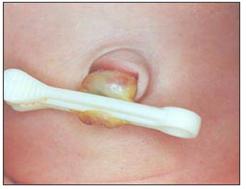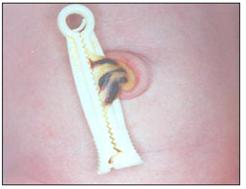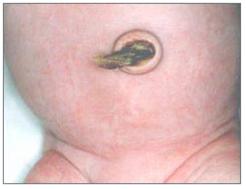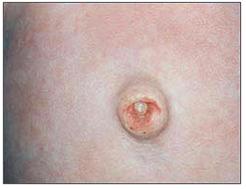신생아의 배꼽과 탯줄 간호, Cares for umbilicus and umbilical cord of newborn infants

사진 2-295.갓 태어난 신생아의 탯줄이 길게 잘려 있다.
머리통이 몰딩으로 이상하고 길다. 이것도 정상이다.
Copyright ⓒ 2011 John Sangwon Lee, MD., FAAP

사진 2-296.탯줄 클램프.
Copyright ⓒ 2011 John Sangwon Lee, MD., FAAP
- 탯줄은 태아의 배꼽에서 태반까지 연결되어 있는 육관의 일종이다.
- 탯줄의 주성분은 젤리 같은 교질이다.
- 그 탯줄 속에 두 개의 동맥과 한 개의 정맥이 들어있다.
- 만삭으로 출생한 아기의 탯줄의 직경은 1cm 정도이고 길이는 1m 정도이다.
- 태아에게 필요한 산소 및 영양분 등이 탯줄 정맥을 통해서 모체로부터 공급되고, 태아의 핏속에 있는 노폐물이 탯줄 동맥을 통해서 태반과 엄마에게로 배설된다(p.00 탯줄은 언제쯤 떨어지나요? 참조).
- 신생아의 탯줄과 배꼽 등에 황색 포도상구균, B군 연구균, 또는 대장균 등 세균 감염이 생기지 않게 예방해야한다.
- 출생 후 바로 아기 배꼽에서 2.5~3㎝ 정도 떨어진 탯줄 부위를 베타다인 살균 소독 액(Providone-iodine)을 바르고 그 부분을 멸균 소독된 실로 동여매든지 탯줄 클램프로 조인다.
- 그 다음, 실로 동여맨 탯줄 부위, 또는 클램프한 탯줄 부위에서 약 0.5cm 떨어진 태반 있는 쪽의 탯줄 부분을 소독된 가위로 잘라 아기를 태반으로부터 분리한다.
- 신생아들의 배꼽에 붙어 있는 탯줄 부분을 베타다인 살균 소독 액 등으로 탯줄이 말라 떨어질 때까지 매일 살균 처리한다.
- 탯줄을 베타다인 살균 액제로 살균 처리 하는 대신 트리플 다이((Triple dye/3중 색소액제) 등으로 살균 처치하기도 한다.
- 더러는 아무런 살균제로도 탯줄을 살균 처치를 하지 않고 자연적으로 건사시킨다.
- 배꼽에 붙어 있는 탯줄 부분은 1~2주 후면 배꼽에서 완전히 말라 떨어지는 것이 보통이다.
- 탯줄을 자연적으로 건사되면 생후 1 주일에 탯줄이 말라 배꼽에서 떨어지는 것이 보통이다.
- 트리플 다이로 살균처치하면 생후 15일~21일에 건사된 탯줄이 배꼽에서 떨어지는 것이 보통이다.
- 배꼽에 붙어 있는 탯줄 부분이 생후 3주 이후에도 떨어지지 않으면 배꼽이나 탯줄에 세균 감염이 생기기 쉽고, 또 그 세균 감염이 점점 더 퍼져 제염, 세균성 뇌막염, 중이염, 항문 주위염 등이 생길 수도 있다.
- 때로는 요막관 낭종이나 면역 결핍증 등이 있을 때 탯줄이 더 늦게 떨어질 수 있다.
- 탯줄이 말라 떨어질 때까지 탯줄과 탯줄이 붙어 있는 배꼽을 베타다인 살균액제 등으로 살균 처치시킬 수도 있다.
- 소독용 알코올로 매일 살균처치해도 아무 효과가 없다고 한다. 그래서 탯줄 건사에 소독용 알코올을 권장하지 않는다.
- 탯줄을 탯줄 클램프로 조인 후 1∼3일에 그 탯줄 클램프를 뗀다.
- 배꼽에 붙어 있는 탯줄을 거즈로 덮어 치료할 필요가 없다.
- 탯줄이 떨어지기 전까지 배꼽에 붙어 있는 탯줄이나 배꼽에서 피가 나는지, 배꼽에 세균감염이 생겨 제염이나 근육막염 등이 생기는지 자주 살펴봐야 한다.
- 탯줄이 완전히 말라 떨어지기 전에 가능하면 탯줄을 물에 적시지 말고 거즈나 약솜구로 목욕시켜야 한다.
- 탯줄이 배꼽에서 떨어진 후 탯줄이 붙어 있던 배꼽의 중앙 부분에 고름과 비슷한 누런 진물이 조금 묻어 있을 수 있다.
- 베타다인 살균액제를 묻힌 약솜이나 거즈로 그 배꼽을 닦는다.
- 탯줄이 붙어 있는 배꼽이나 탯줄이 떨어진 배꼽에서 진물이나 피가 나면 의사의 진단 치료를 받는다.
- 탯줄이 배꼽에서 떨어진 후 생살이 배꼽에서 자랄 수 있고, 그 생살에서 맑은 진물이 날 수 있다.
- 이 생살을 제육아종이라 한다.
- 생살은 질산은 봉으로 지져 주면 쉽게 낫는다(제육아종 참조).
- 배꼽에 포도상 구균, B군 용혈성 연구균, 또는 대장균 등 박테리아 감염이 생기면 배꼽이 곪을 수 있다. 이것을 제염이라 한다. 제염이 생기면 의사의 진단 치료를 곧 받아야 한다. 배꼽 염증(제염) 참조.

사진 2-297.갓 태어나 신생아의 탯줄을 탯줄 크램프로 조인 후 신생아의 탯줄
Copyright ⓒ 2011 John Sangwon Lee, MD., FAAP

사진 2-298.탯줄 크램프로 조인 신생아의 탯줄
한 개의 탯줄 정맥과 두 개의 탯줄 동맥이 건사된 상태로 보인다.
Copyright ⓒ 2011 John Sangwon Lee, MD., FAAP

사진 2-299.잘 건사된 탯줄과 배꼽.
Copyright ⓒ 2011 John Sangwon Lee, MD., FAAP

사진 2-300.배꼽의 중앙 부분에 누렇고 둥그렇게 보이는 것이 제육아종이다.
Copyright ⓒ 2011 John Sangwon Lee, MD., FAAP
Cares for umbilicus and umbilical cord of newborn infants 신생아의 배꼽과 탯줄 간호

Picture 2-295: The umbilical cord of a newborn baby is cut long. The head is strange and long with molding. This is also normal. Copyright ⓒ 2011 John Sangwon Lee, MD., FAAP

Photo 2-296. Umbilical cord clamp. Copyright ⓒ 2011 John Sangwon Lee, MD., FAAP
- The umbilical cord is a type of flesh tube that is connected from the belly button of the fetus to the placenta.
- The main component of the umbilical cord is a jelly-like colloid.
- The umbilical cord contains two arteries and one vein.
- The umbilical cord of a full-term baby is about 1cm in diameter and about 1m in length. Oxygen and nutrients necessary for the fetus are supplied from the mother through the umbilical vein, and waste products in the fetus’ blood are excreted to the placenta and mother through the umbilical cord arteries (see When does the umbilical cord fall?).
- It is necessary to prevent bacterial infections such as Staphylococcus aureus, group B research bacteria, or E. coli in the umbilical cord and navel of newborns.
- Immediately after birth, apply betadine disinfectant solution (Povidone-iodine) to the umbilical cord area 2.5~3cm away from the baby’s belly button, and then tie the part with a sterilized thread or fasten it with an umbilical cord clamp.
- Then, cut the umbilical cord portion tied with a thread or the portion of the umbilical cord on the side of the placenta about 0.5cm away from the clamped umbilical cord with sterilized scissors to separate the baby from the placenta.
- The portion of the umbilical cord attached to the navel of newborns is sterilized every day with betadine sterilizing disinfectant until the umbilical cord dries out. Instead of sterilizing the umbilical cord with betadine sterilizing liquid,
- it is sometimes sterilized with a triple dye or the like. In some cases,
- the umbilical cord is naturally dry without any disinfectant treatment. The part of the umbilical cord attached to the navel is usually completely dry from the navel after 1-2 weeks.
- If the umbilical cord is naturally dry, it is common for the umbilical cord to dry out and fall from the belly button in the first week of life.
- When sterilized with a triple die, it is common for the umbilical cord that has been dried on the 15th to 21st days of life to fall from the belly button.
- If the umbilical cord attached to the navel does not fall off after 3 weeks of age, a bacterial infection is likely to occur in the navel or umbilical cord, and the bacterial infection spreads more and more, leading to decontamination, bacterial meningitis, otitis media, and perianalitis.
- Sometimes, the umbilical cord may fall more slowly when you have an allantoic cyst or immunodeficiency.
- Until the umbilical cord dries out, the umbilical cord and the navel attached to the umbilical cord can be sterilized with betadine disinfectant.
- Daily sterilization treatment with rubbing alcohol has no effect. Therefore, rubbing alcohol is not recommended for the dry umbilical cord.
- After tightening the umbilical cord with the umbilical cord clamp, the umbilical cord clamp was removed in the first to three days.
- There is no need to treat the umbilical cord attached to the belly button by covering it with gauze.
- Before the umbilical cord falls, you should often check whether the umbilical cord attached to the navel or bleeding from the navel and bacterial infection in the navel causes decontamination or myositis. Before the umbilical cord is completely dry, the umbilical cord should be bathed with gauze or cotton balls, if possible, rather than soaking it in water.
- After the umbilical cord has fallen from the navel, there may be a little yellowish discharge similar to pus in the central part of the navel where the umbilical cord is attached.
- Wipe the navel with a cotton ball or gauze moistened with betadine disinfectant.
- Seek medical attention if your baby has bleeding or bleeding from the belly button where the umbilical cord is attached or the belly button where the umbilical cord has fallen. After the umbilical cord has fallen off the navel, the raw flesh can grow in the navel, and a clear discharge can come from the raw flesh.
- This raw flesh is called granuloma. Raw flesh can be healed easily if it is made with silver nitrate sticks (refer to Granuloma).
- Bacterial infections such as staphylococcus, group B hemolytic research bacteria, or E. coli in the navel can cause festering.
- This is called decontamination. If decontamination occurs, you should seek medical attention soon. See Navel Inflammation (Decontamination).

Picture 2-297: Newborn’s umbilical cord after fastening the umbilical cord of a newborn baby with an umbilical cord clamp. Copyright ⓒ 2011 John Sangwon Lee, MD., FAAP

Photo 2-298. The umbilical cord of newborn baby clamped with umbilical clamp One umbilical vein and two umbilical arteries appear to be dry. Copyright ⓒ 2011 John Sangwon Lee, MD., FAAP

Picture 2-299: Well-done umbilical cord and belly button. Copyright ⓒ 2011 John Sangwon Lee, MD., FAAP

Photo 2-300. The yellow and round shape of the central part of the belly button is a granuloma. Copyright ⓒ 2011 John Sangwon Lee, MD., FAAP
출처 및 참조 문헌
- www.drleepediatrics.com 제1권 소아청소년 응급 의료
- www.drleepediatrics.com 제2권 소아청소년 예방
- www.drleepediatrics.com 제3권 소아청소년 성장 발육 육아
- www.drleepediatrics.com 제4권 모유,모유수유, 이유
- www.drleepediatrics.com 제5권 인공영양, 우유, 이유식, 비타민, 미네랄, 단백질, 탄수화물, 지방
- www.drleepediatrics.com 제6권 신생아 성장 발육 육아 질병
- www.drleepediatrics.com제7권 소아청소년 감염병
- www.drleepediatrics.com제8권 소아청소년 호흡기 질환
- www.drleepediatrics.com제9권 소아청소년 소화기 질환
- www.drleepediatrics.com제10권. 소아청소년 신장 비뇨 생식기 질환
- www.drleepediatrics.com제11권. 소아청소년 심장 혈관계 질환
- www.drleepediatrics.com제12권. 소아청소년 신경 정신 질환, 행동 수면 문제
- www.drleepediatrics.com제13권. 소아청소년 혈액, 림프, 종양 질환
- www.drleepediatrics.com제14권. 소아청소년 내분비, 유전, 염색체, 대사, 희귀병
- www.drleepediatrics.com제15권. 소아청소년 알레르기, 자가 면역질환
- www.drleepediatrics.com제16권. 소아청소년 정형외과 질환
- www.drleepediatrics.com제17권. 소아청소년 피부 질환
- www.drleepediatrics.com제18권. 소아청소년 이비인후(귀 코 인두 후두) 질환
- www.drleepediatrics.com제19권. 소아청소년 안과 (눈)질환
- www.drleepediatrics.com 제20권 소아청소년 이 (치아)질환
- www.drleepediatrics.com 제21권 소아청소년 가정 학교 간호
- www.drleepediatrics.com 제22권 아들 딸 이렇게 사랑해 키우세요
- www.drleepediatrics.com 제23권 사춘기 아이들의 성장 발육 질병
- www.drleepediatrics.com 제24권 소아청소년 성교육
- www.drleepediatrics.com 제25권 임신, 분만, 출산, 신생아 돌보기
- Red book 29th-31st edition 2021
- Nelson Text Book of Pediatrics 19th- 21st Edition
- The Johns Hopkins Hospital, The Harriet Lane Handbook, 22nd edition
- 응급환자관리 정담미디어
- Pediatric Nutritional Handbook American Academy of Pediatrics
- 소아가정간호백과–부모도 반의사가 되어야 한다, 이상원 저
- The pregnancy Bible. By Joan stone, MD. Keith Eddleman, MD
- Neonatology Jeffrey J. Pomerance, C. Joan Richardson
- Preparation for Birth. Beverly Savage and Dianna Smith
- 임신에서 신생아 돌보기까지. 이상원
- Breastfeeding. by Ruth Lawrence and Robert Lawrence
- Sources and references on Growth, Development, Cares, and Diseases of Newborn Infants
- Emergency Medical Service for Children, By Ross Lab. May 1989. p.10
- Emergency care, Harvey Grant and Robert Murray
- Emergency Care Transportation of Sick and Injured American Academy of Orthopaedic Surgeons
- Emergency Pediatrics A Guide to Ambulatory Care, Roger M. Barkin, Peter Rosen
- Quick Reference To Pediatric Emergencies, Delmer J. Pascoe, M.D., Moses Grossman, M.D. with 26 contributors
- Neonatal resuscitation Ameican academy of pediatrics
- Pediatric Nutritional Handbook American Academy of Pediatrics
- Pediatric Resuscitation Pediatric Clinics of North America, Stephen M. Schexnayder, M.D.
-
Pediatric Critical Care, Pediatric Clinics of North America, James P. Orlowski, M.D.
-
Preparation for Birth. Beverly Savage and Dianna Smith
-
Infectious disease of children, Saul Krugman, Samuel L Katz, Ann A.
- 제4권 모유, 모유수유, 이유 참조문헌 및 출처
- 제5권 인공영양, 우유, 이유, 비타민, 단백질, 지방 탄수 화물 참조문헌 및 출처
- 제6권 신생아 성장발육 양호 질병 참조문헌 및 출처
- 소아과학 대한교과서
|
Copyright ⓒ 2015 John Sangwon Lee, MD., FAAP 미국 소아과 전문의, 한국 소아청소년과 전문의 이상원 저 “부모도 반의사가 되어야 한다”-내용은 여러분들의 의사로부터 얻은 정보와 진료를 대신할 수 없습니다. The information contained in this publication should not be used as a substitute for the medical care and advice of your doctor. There may be variations in treatment that your doctor may recommend based on individual facts and circumstances. “Parental education is the best medicine.” |